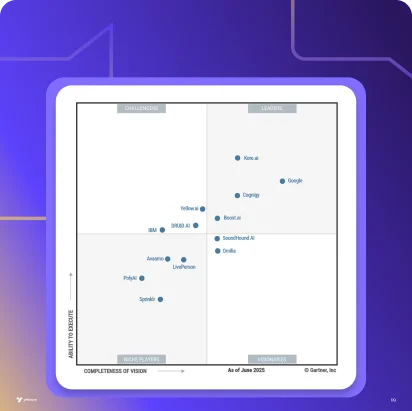Summary
With insurance voice bots, there is a visible shift in how we interact with our insurance providers! Till now, you must have called the customer service team of your insurance provider to ask questions about your policy or filing a claim. Let’s say you need to know if your policy covers a cracked windshield. Traditionally, you’d navigate menus and wait on hold. But with a voice bot, you can ask your question directly and receive an immediate answer, all hands-free! This shift towards direct and efficient communication is why many insurance companies are rapidly adopting voice bot technology.
This blog provides an in-depth overview of the world of insurance voice bots and educates you on everything you need to know. We’ll explore the definition and role of voice bots in the insurance industry, discern conversational AI and its significance, and discuss the difference between insurance chatbots and AI assistants. Finally, we’ll peek into the future and explore potential trends for voice bots in insurance.
Related must-reads:
- AI Voice Bot – The complete guide to voice chat
- What are voice bots and their use-cases for different industries?
- Voice AI – What is it and benefits of voice AI for business
- How voice bots are transforming customer service in 2024?
- Voice bot in banking: Transforming customer interactions in 2024
Insurance voice bot 101
Definition of insurance voice bots: They can be defined as AI-powered voice assistants that engage with customers. The interaction can be used to provide information, fulfill requests, and automate various processes. Such insurance voice bots offer several benefits, including 24/7 customer support, streamlined claims processing, enhanced data security, multilingual communication, and cost reduction. They also boost agent productivity, customer engagement, and efficient lead generation. Integrated with voice recognition technologies, insurance voice bots interact with users through spoken language, enabling hands-free, conversational experiences via applications like smart speakers and virtual assistants.
Introduction to conversational AI and its significance in the insurance industry:
At the core of insurance voice bot is conversational AI, which transforms how insurers interact with clients. This technology allows for seamless communication, handling inquiries and explaining complex policy details with precision. By integrating with existing CRM systems, voicebots utilize historical data to personalize conversations, ensure regulatory compliance, and generate actionable insights through analytics. These capabilities not only increase customer satisfaction and reduce operational delays but also position insurance companies at the forefront of digital transformation in customer service.
Use cases for insurance voice bots
Insurance voice bots have many use cases that significantly improve customer engagement and ease operations. One primary application is handling the initial stages of insurance claim processing. Through them, customers can easily raise claims and give required details. They also provide updates through voice interactions, leading to faster turnaround times for basic claims. This automation permits human agents to take on more complex situations, improving overall efficiency.
Insurance voice bots are pro at answering policyholder queries and furnishing instant responses about coverage, premiums, and policy details. They can generate personalized quotes by gathering customer information and facilitate claims processing by enabling customers to report and complain incidents and track the status of their claims. Voice bots also assist in policy management, including updates and renewals, and can send payment reminders while processing payments efficiently. Post-interaction, these bots gather feedback to enhance services and aid in fraud detection by analyzing claims data and flagging inconsistencies for further review. These diverse applications drive efficiency, reduce costs, and improve customer satisfaction, making insurance voice bots an invaluable tool in the insurance industry. Let’s understand it better.
Customer service and support
Insurance voice bots enhance customer service and support by providing timely and accurate information to policyholders.
- Policy inquiries and information
Insurance voice bots are particularly effective in handling policy inquiries and providing detailed information. Customers can use these bots to ask about coverage details, premium amounts, and policy terms. The voice bots deliver instant responses, ensuring customers receive accurate and up-to-date information without waiting for a human agent. This accessibility enhances customer satisfaction.
- Claim status updates and assistance
These AI-powered voice agents also aid customers by extending claim status updates and assistance. Using simple voice interactions, customers can effortlessly check the status of their claims, receive updates on processing times, and get guidance on the next steps. Insurance being an emergency need, getting such immediate access to claim information reduces customer anxiety and improves overall satisfaction, as customers stay supported throughout the claims process.
- Risk assessment
Voice bots can assist in collecting data for risk assessment by conducting initial screenings of applicants based on voice interactions. They can ask pertinent questions regarding the applicant’s background, property details, or health, depending on the type of insurance, and feed this data back into the system for preliminary risk evaluation.
- Training and onboarding
Voice bots can help new customers understand their policies and the services available to them, ensuring they know how to make claims, what their policies cover, and how to contact human agents for complex issues.
Policy management
Insurance voice bots significantly improve policy management by assisting customers with renewals, policy modifications, and personalized recommendations.
- Renewals and policy modifications
Insurance voice bots ease the renewal process by sending reminders, guiding policyholders through renewal steps, and allowing them to review and update their coverage easily. Likewise, when it comes to policy modifications, voice bots enable customers to adjust coverage levels, update personal information, and request changes without needing to contact an agent. This provides a more efficient self-service experience, saving time for both customers and agents.
- Personalized policy recommendations
Voice bots in insurance excel in suggesting personalized policy recommendations. They do it by analyzing customer data and preferences. This helps existing and potential customers select the most suitable coverage options based on their unique needs and circumstances. This automation improves customer satisfaction and reduces the workload for insurance agents, enhancing overall efficiency and customer engagement.
- Integration with IoT Devices
For insurance sectors like health and automotive, voice bots can be integrated with IoT devices. They can process real-time data provided by these devices to monitor health stats or driving behavior, which can be used for personalized insurance plans and preventive customer service.
Claims processing
Insurance voice bots transform claims processing by streamlining claims submission and providing real-time updates and support.
- Streamlining claims submission
Insurance voice bots simplify the claims submission process by allowing customers to report incidents and provide necessary details through voice interactions. This automation ensures that claims are submitted quickly and accurately, reducing the need for extensive paperwork and manual entry. By guiding users through each step, voice bots help minimize errors and expedite the initial stages of claims processing.
Give your insurance brand a voice to remember
- Providing real-time updates and support
By deploying insurance voice bots, businesses can provide real-time updates and support throughout the claims process. Customers can check their claim status, receive notifications on processing times, and get assistance with any questions or issues that may pop up. This continuous attention enhances transparency, reduces customer anxiety, and improves overall satisfaction by keeping policyholders informed and supported at every stage of their claims journey.
Insurance chatbots and AI assistants
Insurance chatbots and AI assistants have brought a sea change in customer service in the insurance sector. The rise of voice-enabled automated assistance through voice bots is the latest buzz in this space. Leveraging advanced AI technologies like NLP and ML, these tools can handle policy inquiries, renewals, claims submissions, and real-time support with impressive accuracy and efficiency. By automating routine tasks, they boost customer satisfaction and slash operational costs.
These tools fall within the broader category of chatbots and AI assistants used across various industries. Whether text-based or voice-based, these AI-driven assistants engage in human-like conversations, providing 24/7 support and minimizing human intervention in repetitive tasks. In the insurance industry, their ability to offer personalized, adaptive, and efficient service makes them indispensable for modernizing customer interactions and enhancing operational efficiency. These technologies’ continuous learning and adaptability pave the path for customer service innovation.
Comparison: Insurance chatbots and AI assistants vs. voice bots
While insurance chatbots and voice bots may sound similar, they have distinct functionalities that make them suitable for different customer service applications.
Key differences:
- Interaction mode: Chatbots are text-based, while voice bots use spoken language.
- Accessibility: Voice bots are ideal for hands-free interactions, whereas chatbots require typing.
- Complexity handling: Voice bots excel in complex, conversational queries; chatbots handle structured interactions well.
- Speed of response: Voice bots can provide instant verbal feedback; chatbots may involve slight delays in text exchanges.
- User experience: Voice bots offer a more natural, conversational experience; chatbots are suited for straightforward, text-based tasks.
Complementary functionalities:
- 24/7 Support: Both provide around-the-clock customer assistance.
- Task automation: Automate routine inquiries and processes efficiently.
- Data collection: Gather and analyze customer data to improve services.
- Personalization: Deliver personalized interactions based on customer data.
- Integration: Effortlessly integrate with existing systems and databases to access policy information and updates.
Benefits for insurance companies
Insurance chatbots and AI assistants, especially voice bots, revolutionize the insurance sector, enhancing customer experience and optimizing operations.
Enhanced customer engagement
Bots in insurance customer service significantly boost customer engagement by providing instant, personalized responses. Available 24/7, they ensure customers receive assistance anytime without delays. For example, imagine a customer needing policy details at 2 AM; a voice bot can instantly provide this information, understanding the customer’s intent and sentiment. This interactive experience increases customer satisfaction and loyalty, as users always feel supported and valued.
Operational efficiency and cost savings
Insurance voice bots streamline operations by automating repetitive tasks like claims processing, policy renewals, and information updates. Reducing manual processing errors and improved efficiency make insurance voice bots indispensable for modern insurers aiming to optimize operations and enhance profitability. For instance, a voice bot can simultaneously handle thousands of claim submissions, freeing human agents to tackle complex issues. This automation reduces the need for a large customer service team, leading to substantial cost savings.
Future trends of voice bots in insurance
The future of voice bots in insurance is set to be transformative, driven by advancements in AI and emerging technologies. These innovations will significantly impact the insurance industry’s customer service and operational efficiency.
AI advancements and their impact on voice bots
The insurance sector is being transformed by AI-powered voice bots that provide intelligent, tailored, and efficient consumer interactions. Generative AI, NLP, SLU, and Machine Learning are significant advances. Voice bots can grasp consumer intent, context, and sentiment and react naturally to inquiries using these technologies. Integration with other systems lets speech bots access customer and policy data to provide tailored support and automate form completion and claims processing.
Predictions for the next 5-10 years
By 2030, claims processing will remain a main function of carriers. However, more than half of claims activities will be automated. Advanced algorithms will handle initial claims routing, increasing efficiency and accuracy. According to McKinsey & Company, the use of AI by insurers could lead to a 40% decrease in operating expenses by 2030. Additionally, AI-powered insurance experiences have been found to increase customer satisfaction by up to 20%, according to Capgemini. Over 40% of insurance clients would switch carriers without fundamental digital capabilities, according to PWC. Insurers not pursuing AI-powered projects will fall behind.
Emerging technologies and their potential uses
Emerging technologies like Large Language Models (LLMs), low-code/no-code development, telematics, IoT integration, and predictive analytics enhance insurance voice bot functionality. LLMs automate repetitive tasks, improve claims processing, and strengthen underwriting accuracy. Low-code/no-code development allows quick deployment without extensive technical expertise. Telematics and IoT integration provides real-time insights and personalized policy recommendations. Predictive analytics anticipates customer needs, streamlines claims processing, and offers tailored insurance solutions.
Voice bots for insurance: Key takeaways
Insurance voice bots are revolutionizing the industry by supercharging customer service and streamlining operations. Key points discussed include their pivotal role in handling policy inquiries, renewals, and modifications, simplifying claims processing and providing real-time support. Future trends highlight AI advancements, predictive analytics, and emerging technologies like IoT and blockchain, further boosting voice bot capabilities.
Voice bots in the insurance sector are essential for driving efficiency, slashing operational costs, and elevating customer satisfaction. By automating repetitive tasks and delivering personalized assistance, these bots empower insurance companies to provide top-notch service while allowing human agents to focus on more complex interactions. As AI and related technologies continue to advance, integrating voice bots will be vital for insurers looking to stay ahead of the curve and meet the ever-increasing expectations of their customers.























